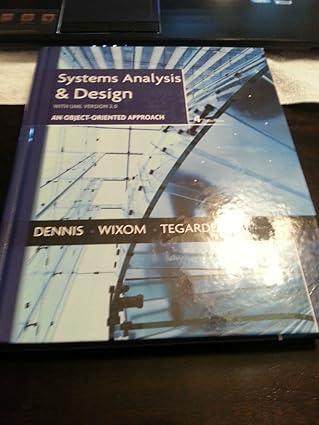For the A Video Store problem in Chapters 4 (exercises L, M, and N) and 5 (exercises
Question:
For the A Video Store problem in Chapters 4 (exercises L, M, and N) and 5 (exercises R and S):
1. Choose one use case and, for each scenario, create a sequence diagram.
2. Create a communication diagram for each scenario of the use case chosen in Question 1.
3. Create a behavioral state machine to depict one of the classes on the class diagram you created for Chapter 5, exercise R.
4. Perform a CRUDE analysis to show the interactivity of the objects in the system.
5. Perform a verification and validation walkthrough of the problem.
Exercises L, M, and N In Chapter 4
L. Draw a use-case diagram and a set of activity diagrams for the following system. A Video Store (AVS) runs a series of fairly standard video stores. Before a video can be put on the shelf, it must be cataloged and entered into the video database. Every customer must have a valid AVS customer card in order to rent a video. Customers rent videos for three days at a time.
Every time a customer rents a video, the system must ensure that he or she does not have any overdue videos. If so, the overdue videos must be returned and an overdue fee paid before customer can rent more videos. Likewise, if the customer has returned overdue videos but has not paid the overdue fee, the fee must be paid before new videos can be rented. Every morning, the store manager prints a report that lists overdue videos. If a video is two or more days overdue, the manager calls the customer to remind him or her to return the video. If a video is returned in damaged condition, the manager removes it from the video database and may sometimes charge the customer.
M. Create a set of detailed use-case descriptions for the video system in exercise L.
N. Perform a verification and validation walkthrough of the functional models of the video store system described in exercises L and M.
Exercises R and S In Chapter 5
R. Using the seven-step process described in this chapter, create a structural model for exercise L in Chapter 4.
S. Perform a verification and validation walkthrough for the structural model created for exercise R.
Step by Step Answer:

Systems Analysis And Design With UML 2.0
ISBN: 9781118037423
4th Edition
Authors: Alan Dennis, Barbara Haley Wixom, David Tegarden




